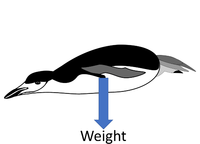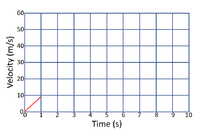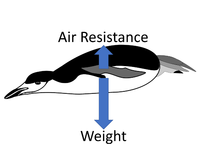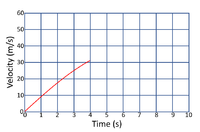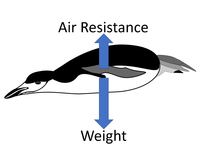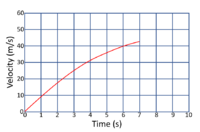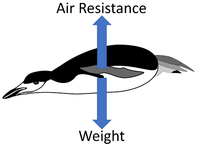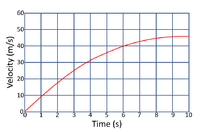Difference between revisions of "Terminal Velocity"
(→About Terminal Velocity) |
|||
| Line 5: | Line 5: | ||
===About Terminal Velocity=== | ===About Terminal Velocity=== | ||
'''Terminal velocity''' depends on: | '''Terminal velocity''' depends on: | ||
| − | *The [[density]] of an [[object]] - The more [[dense]] an [[object]] the greater the '''terminal velocity''' because larger [[object]]s will experience greater [[Air Resistance|air resistance]] at a given [[speed]]. | + | *The [[density]] of an [[object]] - The more [[dense]] an [[object]] the greater the '''terminal velocity''' because larger [[object]]s (of the same weight) will experience greater [[Air Resistance|air resistance]] at a given [[speed]]. |
*The shape of an [[object]] - The more [[streamline]]d an [[object]] the greater the '''terminal velocity''' because they experience less [[Air Resistance|air resistance]] at a given [[speed]]. | *The shape of an [[object]] - The more [[streamline]]d an [[object]] the greater the '''terminal velocity''' because they experience less [[Air Resistance|air resistance]] at a given [[speed]]. | ||
: '''Terminal velocity''' is the maximum [[velocity]] an [[object]] will reach when falling due to [[gravity]]. | : '''Terminal velocity''' is the maximum [[velocity]] an [[object]] will reach when falling due to [[gravity]]. | ||
| Line 29: | Line 29: | ||
|[[File:TerminalVelocityGraph2.png|center|200px]] | |[[File:TerminalVelocityGraph2.png|center|200px]] | ||
|- | |- | ||
| − | |[[File: | + | |[[File:TerminalVelocity3.png|center|200px]] |
| style="height:20px; width:200px; text-align:left;" |As the penguin [[accelerate]]s more its hight [[velocity]] results in more [[Air Resistance|air resistance]] that acts against its [[weight]]. | | style="height:20px; width:200px; text-align:left;" |As the penguin [[accelerate]]s more its hight [[velocity]] results in more [[Air Resistance|air resistance]] that acts against its [[weight]]. | ||
| Line 37: | Line 37: | ||
|[[File:TerminalVelocityGraph3.png|center|200px]] | |[[File:TerminalVelocityGraph3.png|center|200px]] | ||
|- | |- | ||
| − | |[[File: | + | |[[File:TerminalVelocity4.png|center|200px]] |
| style="height:20px; width:200px; text-align:left;" |Once the penguin is moving fast enough the [[velocity]] results in an [[Air Resistance|air resistance]] that is as large as the [[weight]]. | | style="height:20px; width:200px; text-align:left;" |Once the penguin is moving fast enough the [[velocity]] results in an [[Air Resistance|air resistance]] that is as large as the [[weight]]. | ||
Latest revision as of 20:16, 5 January 2020
Key Stage 4
Meaning
Terminal velocity is the velocity a falling object reaches when the forces of drag and weight on that object are balanced.
About Terminal Velocity
Terminal velocity depends on:
- The density of an object - The more dense an object the greater the terminal velocity because larger objects (of the same weight) will experience greater air resistance at a given speed.
- The shape of an object - The more streamlined an object the greater the terminal velocity because they experience less air resistance at a given speed.
- Terminal velocity is the maximum velocity an object will reach when falling due to gravity.
- Terminal velocity occurs because air resistance increases with speed until the air resistance is balanced with the weight, at which point the object will stop accelerating.
| At the start the penguin is not yet moving and the only force acting on the penguin is its weight.
So the resultant force is large which means the acceleration will be large. |
||
| As the penguin starts to accelerate its small velocity results in an air resistance that acts against its weight.
Resultant Force = Weight - Air Resistance So the resultant force is less than it was so the acceleration will be less. |
||
| As the penguin accelerates more its hight velocity results in more air resistance that acts against its weight.
Resultant Force = Weight - Air Resistance So the resultant force is even smaller than it was so the acceleration will be smaller. |
||
| Once the penguin is moving fast enough the velocity results in an air resistance that is as large as the weight.
Resultant Force = Weight - Air Resistance Resultant Force = 0N So there is no resultant force and so the acceleration will be zero. The penguin has reached terminal velocity. |
References
AQA
- Terminal velocity, page 141, GCSE Physics; Student Book, Collins, AQA
- Terminal velocity, page 211, GCSE Combined Science; The Revision Guide, CGP, AQA
- Terminal velocity, page 63, GCSE Physics; The Revision Guide, CGP, AQA
- Terminal velocity, pages 146-147, GCSE Physics; Third Edition, Oxford University Press, AQA
- Terminal velocity, pages 156-7, GCSE Physics, Hodder, AQA
- Terminal velocity, pages 159-161, GCSE Combined Science Trilogy; Physics, CGP, AQA
- Terminal velocity, pages 190-192, GCSE Physics; The Complete 9-1 Course for AQA, CGP, AQA
- Terminal velocity, pages 234-5, GCSE Combined Science Trilogy 2, Hodder, AQA
